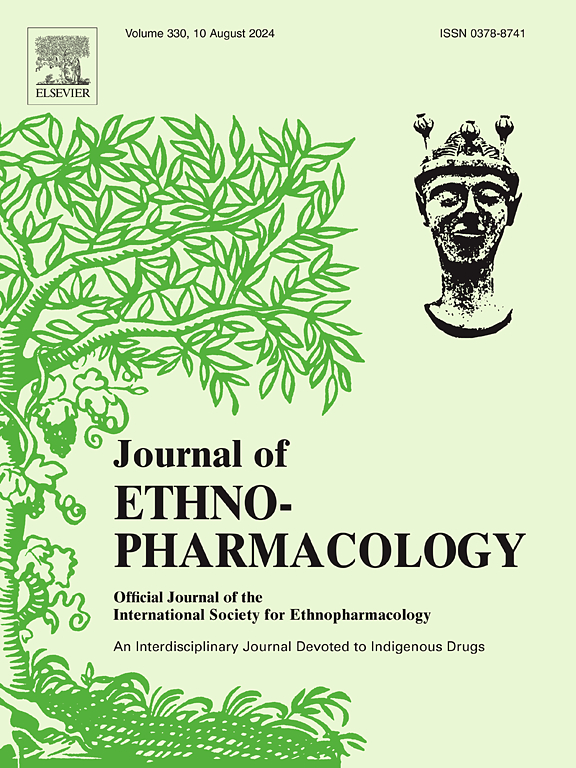12种挪威药用植物的体外抗炎特性。
IF 5.4
2区 医学
Q1 CHEMISTRY, MEDICINAL
引用次数: 0
摘要
民族药理学相关性:今天,炎症性疾病,如类风湿关节炎和炎症性肠病是西方社会的主要健康负担。治疗这类疾病的药物旨在抑制炎症症状。在挪威,几种药用植物都有民族医学上用于治疗各种炎症的历史,这可能是新的抗炎药物的来源。研究目的:本研究的重点是探索在挪威未被充分研究的传统药用植物治疗不同来源炎症的潜力。通过植物化学和生物学筛选方法,我们旨在鉴定出具有抗炎特性的植物,这些植物也显示出高比例的酚类化合物。基于这些结果,这些植物将对进一步的工作产生兴趣和相关性,包括分离和表征可能作为新型抗炎药的植物化学物质。材料和方法:对19世纪以来的历史记录进行了系统的文献调查,寻找用于治疗各种炎症性疾病的植物。选择12株植物进行加速溶剂萃取,得到富含酚类化合物的提取物,即二氯甲烷和80%乙醇提取物。这些都在生物测定中进行了研究,以评估它们的体外抗炎作用。测定其抑制一氧化氮(NO)和TNF-α细胞因子产生的能力,并利用分化的Caco-2细胞评估其对吲哚美辛诱导的肠上皮屏障损伤的保护作用。测定提取液中总酚含量,并用1H NMR和HPLC-DAD进行植物化学分析。结果:白骨精、白骨精、天竺葵、白骨精、白骨精、白骨精、白骨精具有中高的生物活性。二氯甲烷提取物对NO和TNF-α的抑制作用更强,而80%乙醇提取物对屏障完整性的保护作用更强。尤其令人感兴趣的是,disidea, A. incana和G. sylvatium表现出一贯的高生物活性。它们的1H NMR谱也显示出高比例的酚类化合物。结论:鸢尾草和盘状鸢尾草的生物活性和化学成分研究较少,是发现新型抗炎药物的潜在候选者。在此基础上,下一步的工作将集中在这两种植物上,包括分离酚类化合物和评估其生物活性。本文章由计算机程序翻译,如有差异,请以英文原文为准。

In vitro anti-inflammatory properties of twelve Norwegian medicinal plants
Ethnopharmacological relevance
Today, inflammatory diseases such as rheumatoid arthritis and inflammatory bowel disease represent a major health burden in Western societies. Such diseases are treated with drugs aiming at suppressing inflammatory symptoms. In Norway, several medicinal plants share a history of ethnomedical use towards the treatment of various inflammatory conditions which could represent sources of new anti-inflammatory drugs.
Aim of the study
This study focused on exploring the potential of understudied traditional medicinal plants used in Norway to treat inflammation of different origin. Through phytochemical and biological screening methods, we aimed to identify plants with anti-inflammatory properties that also showed a high proportion of phenolic compounds. Based on these results, such plants would be of interest and relevance for further work including isolation and characterization of phytochemicals that could serve as novel anti-inflammatory drugs.
Materials and methods
A systematic literature survey of historical records from the 1800s and onwards was performed searching for plants used to treat various inflammatory diseases. Twelve plants were selected and subjected to accelerated solvent extraction to obtain extracts rich in phenolic compounds, namely dichloromethane and 80 % ethanol extracts. These were studied in bioassays assessing their in vitro anti-inflammatory effects. Their ability to inhibit nitric oxide (NO) and TNF-α cytokine production was measured, and their protection against indomethacin induced damage of the intestinal epithelial barrier was evaluated using differentiated Caco-2 cells. The total phenolic content of the extracts was determined, and 1H NMR spectroscopy and HPLC-DAD was performed for phytochemical profiling.
Results
Several of the plants presented moderate to high bioactivity, namely Matricaria discoidea, Alnus incana, Geranium sylvaticum, Antennaria dioica, Tanacetum vulgare and Malva moschata. A stronger effect was observed among the dichloromethane extracts in NO and TNF-α inhibition, while the 80 % ethanol extracts showed greater protection of the barrier integrity. M. discoidea, A. incana and G. sylvaticum are of particular interest, presenting consistently high bioactivity. Their 1H NMR spectra also showed a high proportion of phenolic compounds.
Conclusion
Both A. incana and M. discoidea are scarcely studied regarding their bioactivity and chemical composition, being potential candidates for the discovery of novel anti-inflammatory drugs. Based on the results obtained from this study, further work will focus on these two plants, including isolation of phenolic compounds and assessing their biological activities.
求助全文
通过发布文献求助,成功后即可免费获取论文全文。
去求助
来源期刊

Journal of ethnopharmacology
医学-全科医学与补充医学
CiteScore
10.30
自引率
5.60%
发文量
967
审稿时长
77 days
期刊介绍:
The Journal of Ethnopharmacology is dedicated to the exchange of information and understandings about people''s use of plants, fungi, animals, microorganisms and minerals and their biological and pharmacological effects based on the principles established through international conventions. Early people confronted with illness and disease, discovered a wealth of useful therapeutic agents in the plant and animal kingdoms. The empirical knowledge of these medicinal substances and their toxic potential was passed on by oral tradition and sometimes recorded in herbals and other texts on materia medica. Many valuable drugs of today (e.g., atropine, ephedrine, tubocurarine, digoxin, reserpine) came into use through the study of indigenous remedies. Chemists continue to use plant-derived drugs (e.g., morphine, taxol, physostigmine, quinidine, emetine) as prototypes in their attempts to develop more effective and less toxic medicinals.
 求助内容:
求助内容: 应助结果提醒方式:
应助结果提醒方式:


